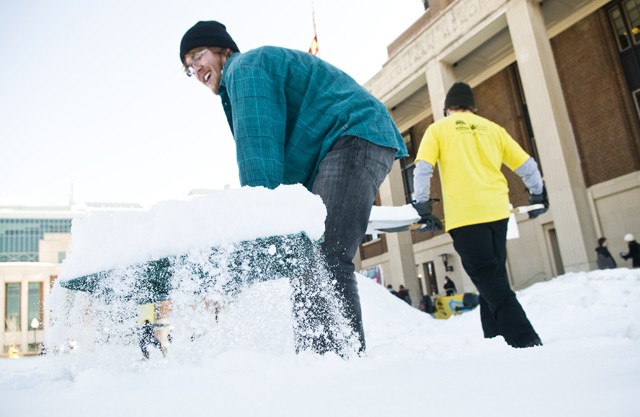Equipped with shovels and flyers, members from the University of Minnesota student group Campus Beyond Coal constructed a 10-foot snow mountain in front of Coffman Union to raise awareness for the environmental implications of mountain top removal mining. The event, dubbed âÄúSnow Mountain,âÄù was organized by Campus Beyond Coal, which partners with the Sierra Club student coalition. Campus Beyond Coal aims to encourage University officials to move away from coal dependence as an energy source. âÄúWeâÄôre asking the University to move beyond coal as soon as feasibly possible,âÄù said Sierra Club volunteer Tim Harlan-Marks. In fiscal year 2009 the University burned 38,740 tons of coal, according to Campus Beyond Coal. The University operates two steam plants located in Southeast Minneapolis and St. Paul. Aside from coal, the plants also burn biomass and natural gas. Coal plants contribute to 30 percent of U.S. carbon emissions, according to the group. Currently, no coal mining takes place in Minnesota, so a large majority of the coal is gathered from the Appalachia region, where mountaintop removal is prevalent. Mountaintop mining is a removal process wherein mining companies detonate explosives to expose areas where coal can be found. The excess waste resulting from the explosion is then tossed into nearby lakes and rivers, disturbing local ecosystems and emitting harmful toxins such as arsenic and mercury into the atmosphere. The toxins have also been reported to affect nearby residential communities in the rural areas. Sarah Vig, a Sierra Club volunteer organizer, reported on the affects of mountain top removal for the non-profit publication, the Appalachian Voice. Vig said that because of lenient environmental standards, enormous amounts of waste are generated through these operations, which affect both the local communities and the water sources surrounding them. âÄú[The waste] contaminates water resourcesâÄù Vig said. In addition to the rubble that spills out into the surrounding area, Vig said that large amounts of silica dust accumulate, which cause air pollution and have been known to cover nearby homes. The dust, if inhaled in large quantities, has the potential to cause serious health risks such as bronchitis. âÄúI was in West Virginia last May where there was some really serious flooding,âÄù Vig said. âÄúLiterally, rubble was washing downhill into peopleâÄôs yards.âÄù Vig added that in places like West Virginia, there had been notable increases in flooding. Approximately 30 members of the group showed up for the event throughout the day. Campus Beyond Coal officer Michael Reynolds gave a speech, and afterward members picked at the top of the mountain with shovels to demonstrate the destruction caused by mountain top removal. According to Campus Beyond Coal President Siri Simons, Snow Mountain is a part of the groupâÄôs ongoing effort to raise awareness about the dangers of coal usage. âÄúWe were thinking of a way to have a really good visual to show whatâÄôs actually going on,âÄù Simons said. This removal method is a financially feasible option for mining companies due to the lack of workers required for the operation. âÄúWe see this as an opportunity for the University to stand out as a sustainability leader,âÄù Harlan-Marks said. The University is a member of the Chicago Climate Exchange and the University Presidents Climate Commitment, both of which pledge climate neutrality and the reduction of greenhouse gas emissions. The University must also meet statewide energy goals, including the renewable portfolio standard, which requires 25 percent renewable energy by 2025.
Student group protests coal mining
The students constructed a 10-foot symbolic snow pile to illustrate the destructive nature of mountaintop removal.

University sophomore Christopher Swanson shovels snow with other Beyond Coal members Thursday in front of Coffman Union to form a “mountain” structure for a demonstration.
by Raghav Mehta
Published February 18, 2010
0

